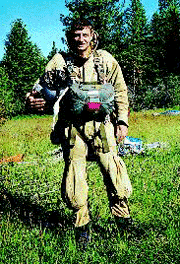
|
FEATURES: CLUB NEWS: PROFESSIONAL SCHOOLS: CLOSE-UPS: |

Into the Inferno
Dan Cottrell (GSESP00) finds parachuting into forest fires an exhilarating challenge.
 Dan Cottrell
|
Cottrell spends half the year in a more conventional career: a substitute teacher in Chicago-area middle schools. But the other half finds him in the western United States, putting out forest fires with a team of highly trained “smokejumpers.” These men and women battle remote blazes by arriving at the scene in the fastest way possible — dropping from the sky.
“I was working a 9-to-5 job, and it just wasn’t challenging enough for me,” Cottrell says, but he soon found the excitement he was looking for. Smokejumpers are often on duty up to 100 hours a week and have to be in peak physical condition. They’re dropped from the planes with 70 pounds of equipment and spend days at a time using shovels to dig fire lines and cutting down trees to prevent the blaze from spreading.
Although the smokejumpers take special precautions, wearing fire-resistant suits, hardhats and boots, it’s still a risky business, especially the jump from the plane.
In 2001 Cottrell was one of 12 who took a difficult jump into Montana’s Gallatin National Forest. The team parachuted into high winds as night was approaching, and ended up with six firefighters caught in trees and one with a broken leg. “It was never at a point where I felt we were in danger, but we definitely weren’t comfortable with the situation,” Cottrell says. “The fire had spread from half an acre to 3,000 acres in 24 hours.”
Cottrell, a Northfield, Ill., resident, started fighting fires as a summer job in 1995, when he was an undergraduate at the University of Wisconsin. When he heard about the smokejumpers, part of the U.S. Forest Service, he was intrigued. For three consecutive years Cottrell applied to join the select group, based in Missoula, Mont., and on his third try, he was accepted. Since then, in addition to Montana, he’s jumped into fires in Idaho, Wyoming, North and South Dakota, Minnesota and Washington state.
Cottrell was at Northwestern when he became a smokejumper, and he found the University helpful in making sure he could complete his degree and fight fires at the same time. “I could never go to summer school because summertime was fire time,” he recalls, “and my professors made some real concessions for me.”
Sophie Haroutunian-Gordon, professor of education and director of the SESP program, remembers that as a student, too, Cottrell “would just go in and take the bull by the horns. He clearly was one who went out looking for challenges.”
While Cottrell loves the excitement of smokejumping, he feels the toll it has taken on his body, so his long-term goals include finding a full-time teaching position. Most people are surprised to learn that he loves teaching for the same reasons he loves fighting fires.
“While smokejumping is more physically challenging, in both jobs you never know what to expect,” he says. “The days are always different and you have to think on your feet. If an idea isn’t coming across to your kids in a classroom, you have to be creative and energetic and teach them in a new way.”
Northwestern 1800 Sheridan Road Evanston, IL 60208-1800
Phone: 847-491-5000 Fax: 847-491-3040 E-mail: letters@northwestern.edu
Last updated 04/04/2003
World Wide Web Disclaimer and University Policy Statements
© 2002 Northwestern University